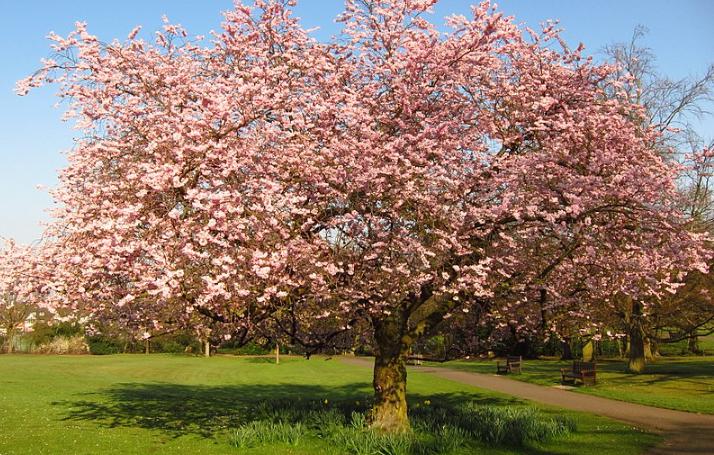Cherry trees are known for being breathtakingly beautiful not only because of their beautiful canopy, but especially during the blooming season. It is a great addition to any home or commercial garden and is sure to impress onlookers as they walk or drive by your house.
However, as it continues to grow, it can turn out to actually be a nuisance as well – especially if not groomed properly. Many people planting cherry trees in their lawns often ask how close to the house can I plant a cherry tree?
When planting a cherry tree, it is important to determine what type of plant you have. At maturity, sweet cherry trees can spread up to 35 feet, dwarf trees up to 10 feet, space tart cherries up to 20 feet, their dwarfs up to 10 feet, so keep that in mind when planting. There are many other types to consider as well, which we’ll discuss in the next section along with other details to keep in mind.
Different Types of Cherry Trees & How Far to Plant Them

Before we consider the details of each tree type, let us look at a chart to give you a better idea, in case you’re in a hurry.
| Cherry Tree Type | Defining Feature | Foliage Spread (ft) | Recommended Distance from House(ft) |
| Sweet Cherries | Reddish-brown wood. Upright. Can go as high as 36 feet. Heart-shaped fruit. | 35-40 | 30-35 |
| Sweet Cherry (Dwarf) | Same as above. Can go as high as 12 feet. | 5-10 | 5-8 |
| Sour/Pie/Tart Cherries | Dense roots. Upright with haphazard branch growth. More foliage on one side. Can go as high as 18-20 feet. | 20-25 | 20-30 |
| Space Tart Cherry (Dwarf) | Same as above. Can go as high as 8-12 feet. | 8-10 | 10 |
| Daybreak (Akebono) | Symmetrical and round. Single flowers. Concentrated foliage. 25-50 feet high. | 25 | 25 |
| Yoshino | Dense and far-spreading roots. Strong roots. Heavy foliage. 40-50 feet high. | 25-40 | 45 |
| Shidare Yoshiko | Also known as the weeping Yoshino. Doesn’t spread as much but has flowering wines hanging from it. 12-20 feet high. | 20-30 | 20 |
| Cascade Snow | Pure white flowers and disease/pest resistant. Elongated growth. 25-40 feet high. | 20 | 20 |
It is important to point out that when calculating the recommended distance from house, we assume that you would be regularly trimming the tree to shape it. If you aren’t going to trim it, we recommend you follow the Foliage Spread column and add at least 5 feet to the same.
Cascade snow and Akebono are considered to be the most resilient cherry trees out there and can grow anywhere, easily. This resistance, in turn, leads to widespread growth of the foliage and root system alike.
As time passes, you will have to keep an eye on their root systems as well. If roots are near your foundation or trying to climb over your sidewalk, don’t hesitate to cut them. These are very hard plants and will crack the concrete without a second thought.
What Happens If I Plant Too Close to the House?
As mentioned above, planting cherry trees too close to your house can be damaging to structures around. The most common problems that may arise include:
Structural Damage

Cherry roots are aggressive and have a way of making a path through almost every material type; especially if moist with water. This can lead to structural damage. Cherry roots try to go through obstacles, unlike those of Oak and Maple tree roots, which try to go around.
Plumbing Damage
It is quite common to find tree roots in plumbing pipes – especially older, brittle ones. Cherry roots can easily make their way through older pipes made of cast iron or clay. Apart from going through the same, roots may also crush plumbing components, therefore springing leaks.
Roofing/Window Damage
Tree branches near or going over your house are a surefire recipe for disaster. Cherry trees will most likely drop cherries near blossom, and seeing how beautiful these trees get, you may not have the heart to cut these limbs during the season.
Branches and other debris can wear away your roof covering or break windows – not to mention how it can provide animals with access to your home. We recommend pruning your cherry tree as it gets closer to your home and roof.
Heaving Damage
As tree roots develop, they thicken up. Roots under driveways, walkways, or even your patio can grow not only to crack them, but also act as a wedge that spreads your structure apart over time. These roots also become a tripping hazard. It is recommended you prune your cherry tree roots that head in the wrong direction – or simply plant the tree away.
What If I Already Have a Cherry Tree Close to My Home?
Cherry trees require full sun to grow. With 6-7 hours of sun next to your home, it will grow from 2 to 6 feet per year and within 10 years, you’ll have a full-canopy tree – with more room to grow. We recommend trimming it early spring to ensure controlled growth and so that it grows away from your home.
However, what if you have already planted a cherry tree too close to your house, or moved into one that already has one planted nearby?
The first thing you will need to do is encourage upward growth by pruning the tree from underneath. Try to raise the canopy by trimming under it. The plant-lovers among you might feel ‘guilty’ cutting buds or areas where new leaves are developing, but you gotta do what you gotta do.
As you cut new-growth areas, after a while the plant will, in the interest of surviving, stop growing from there and move toward ‘safer’ areas; in this case, the top.
We recommend pruning it in a way as to achieve a more compact canopy, i.e., cutting around the tree whenever it tries to escape the ‘stencil’ you want. Just remember that when pruning a weeping tree, the top of the tree is its bottom and the bottom is its top.
Pruning leaves is the easy part; the root ball is slightly more difficult. Depending on how old the plant is, it may have already started making its way into the foundation. Check by scarifying the soil and checking the root system. The roots of a cherry tree are slightly reddish in color (underground), so when scarifying, look for red roots.
Cut any roots that you think are headed into your foundation, sidewalk, driveway, or anywhere you feel they shouldn’t go. You may need anything from a pair of scissors to a sheer, or even a saw to cut roots! Prune several roots on every side to encourage them to grow downward instead of sideways.
When pruning roots, try to space them out as evenly as possible.
Remember, pruning on just one side may end up shocking the tree, causing that side to die or see stunted growth.
Not only will you be clearing the ground of roots that may damage your home, by pruning roots you’d actually improve the tree’s fruit/bloom production. In our experience, you don’t need any special ‘paste’ to reduce chances of disease. The tree is very hardy as is and can live a few odd prunes.
If you really must, add powdered cinnamon in the soil. Other than that, keep the plant well watered without fertilizer after pruning roots.
When pruning, if you find any structural or plumbing damage, it is a good idea to get it fixed immediately. Make sure while pruning that the roots stay away from septic tanks.
